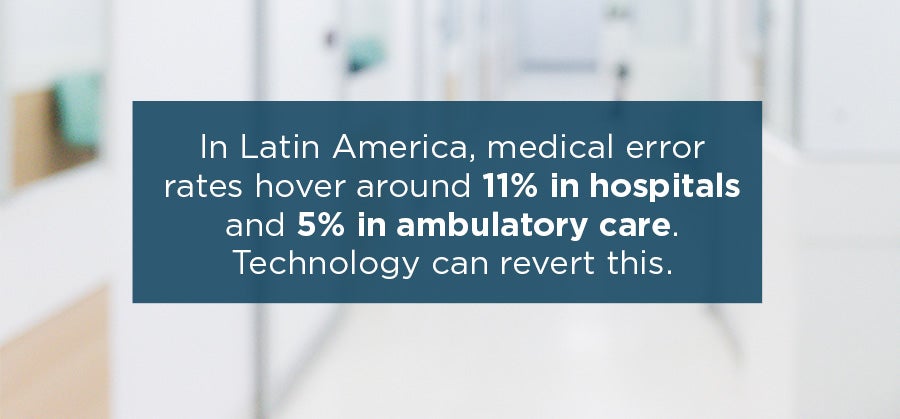Errors in diagnosing are very common, despite being one of the most important aspects of a physician’s role, and can result in avoidable delays in obtaining care, and even death. In the United States, medical error, which includes misdiagnosis and incorrect treatment, is the third leading cause of death. Studies in Latin American countries show that the rate hovers around 11% in hospitals and 5% in ambulatory care.
Reasons for high error rates include short patient visit times, inadequate resources for tests and procedures, and a lack of physician training. Finding a solution has become an urgent global priority in patient safety.
Grassroots and large-scale tech responses
Programs and policies intended to diminish diagnostic error often focus on physician incentives and continued medical training. However, incentives are difficult to determine, effectively calibrate, and implement in a timely fashion. Although vast clinical knowledge exists, physicians lack a comprehensive “map” to guide them beyond the initial diagnosis through treatment, discharge, ongoing care, and prevention.
Consequently, there is an increased demand for simpler, faster, and more flexible responses, demonstrated by recent rapid growth in the number of health workers using social networking tools such as WhatsApp and SMS to train, learn, and help each other on clinical cases. One example are studies that have found that up to 30% of doctors in the United Kingdom’s National Health Service use WhatsApp.
Another tech option that’s helping
The Human Diagnosis Project (Human Dx) is also responding to this need, building an open intelligence system that maps the steps to help any patient. Intended for medical professionals and trainees, the system increases collaboration among the global medical community to reduce misdiagnoses and make more informed clinical decisions.
Using Human Dx, any physician can log on, ask a question, and within hours see the recommendations of other physicians, including confirming or ruling out diagnoses, next steps and management, and often a rationale or a reference. For example, one physician used it to confirm a suspected case of rheumatoid arthritis before initiating a strong course of medications to a low-income patient.
Today, Human Dx* includes over 8,000 contributors from over 80 countries, representing 500 medical institutions. To build this system, innovation is required in two areas: clinical collaboration and interactive medical education.
Digital collaboration and learning has surprising results
Though collaboration among multiple medical professionals can improve diagnostic accuracy and patient outcomes, few systems enable collaboration on a large scale. Researchers from Harvard Medical School and the University of California San Francisco showed that physicians collaborating on Human Dx outperform 95% of individual physicians on diagnosis. Even more significantly, when three or more primary care physicians or residents collaborated on a case, they reached the correct diagnosis up to 29% more frequently than a specialist in that field.
Such technologies have the potential to empower anyone with the world’s collective medical insight. They can reduce the isolation of rural doctors, enabling them to collaborate on any case, question, or medical topic. Medical trainees and new providers are empowered with a resource to practice solving cases and receive immediate feedback on their diagnostic reasoning skills. Eventually, patients will also be able to participate directly, and potentially have access to multiple medical opinions.
Combined, these can all help decrease diagnostic errors, number of specialist visits required, waitlists, and costs.
In addition to collective intelligence, interactive medical education, through more engaging and measurable learning, can likely improve diagnosis. Initiatives like Human Dx achieve this by providing a free and personalized medical education platform for any medical professional to learn through interactive, case-based simulations that more closely mimic clinical practice and assess multiple dimensions of performance.
An accurate diagnosis is the entry point to receiving the most appropriate management. Technologies that enhance collaboration and learning show great promise by training medical providers around the world, from physicians to community health workers, to better triage, diagnose, and treat the most common conditions that can be addressed in resource-poor healthcare settings. Ultimately, this helps to not only improve, but actually save lives.
Do you know of other promising technologies that can transform the health landscape? How could your community and country benefit from similar initiatives? Tell us in the comments section or mention @BIDgente on Twitter.
Joaquin Blaya is a Ph.D. graduate from Harvard-MIT who worked with the National Tuberculosis Program in Peru, and is currently at the Human Diagnosis Project.
Tyler Brandon, a current member of the Human Diagnosis Project, studied global health at Harvard and previously worked on domestic policy in the Obama White House.
*Human Dx is also available for download as an iPhone app. Questions? View the training video.


Leave a Reply